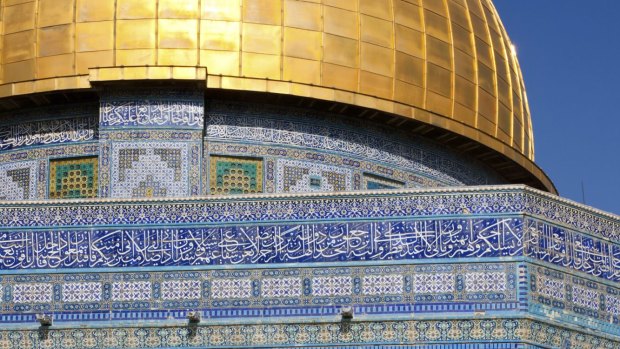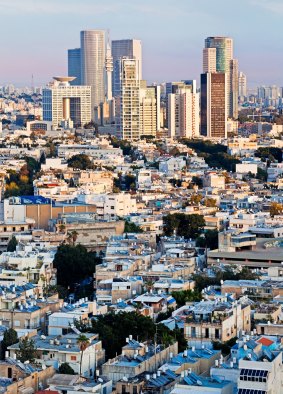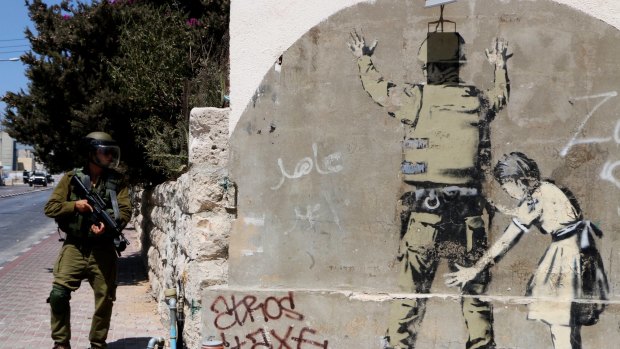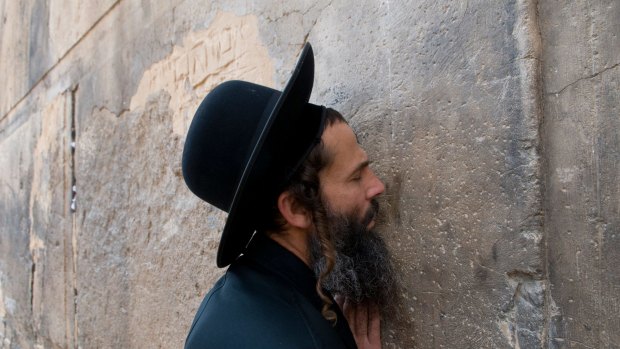This was published 8 years ago
Political tours: A trip to Israel and Palestine
By Sandra Hall

Two Muslim women in front of the Dome of the Rock on the Temple Mount in Jerusalem, Israel.Credit: Jelle van der Wolf
On Israel's West Bank, everybody has a story. On the outskirts of Ramallah, we visit a Palestinian farmer and his family whose home is entirely enclosed by Israel's notorious separation barrier. On one side of their garden is a high cement wall. On the other, a barbed wire fence monitored by cameras and patrolled by Israeli soldiers.
It's been here since 2003. For the first three weeks after its construction, the farmer, Hani Abdullah Ahmed, even lacked the key to his front gate. The soldiers decided when he could come and go and he was denied visitors.
Through an interpreter, he says that he finally got the key after telling the soldiers that they could go ahead and shoot him but he was going to start taking the fence apart.

Tel Aviv, Israel.Credit: Alamy
As we talk, his young grandsons kick a ball around on the dusty patch of ground in front of the wall. He has owned the property for decades, refusing the Israeli government's offer to buy him out because he regards the land as priceless. But the wall went up in spite of his protests, cutting him off from the hectares where he used to plant fruit trees and forcing him to rent more land an hour's drive away.
He delivers his narrative with a fluency born of long practice. He even manages a sly dig at the Palestinian Authority whose representative paid him one visit, arriving seven hours late with the media, who took some pictures. Nothing more? It was nice, he says dryly, to see the pictures on television.
A few days later, in the divided city of Hebron, we meet another Palestinian, Ahmed, a man whose gentle manner masks an equally formidable strength of will. Five years ago, he reclaimed his grandfather's house, which is a few metres from the checkpoint which cuts the city in two and puts Ahmed's home in H2, which is under Israeli military control.

An Israeli soldier walks past by a Banksy graffitti in Bethlehem.Credit: Alamy
While H2 still has a Palestinian majority, many of his neighbours are Jewish settlers, possessed of an unshakeable conviction that they have a God-given right to be here in Hebron, site of the Cave of the Patriarchs, one of the country's holiest shrines.
The school attended by Ahmed's nine year-old daughter is near the settlement and she, too, has stories to tell. One afternoon, she was coming home from school when a settler's child walking behind her clicked a cigarette lighter, setting fire to her hair. Fortunately, an Israeli soldier realised what had happened before she did and put out the flame.
On another occasion, she was not so lucky. She was playing hide-and-seek on the flat roof the family's home when some kids she didn't know pushed her off the roof, breaking her arm.

An ultra orthodox Jewish man at prayer outside Cave of Machpela in Hebron.Credit: Alamy
This visit is part of a study tour I'm taking with Political Tours, a company run by Nicholas Wood, a British journalist who was the New York Times Balkans correspondent before his change of career. He's able to call on a comprehensive range of contacts among journalists, former diplomats and political consultants, who provide briefings along the way but inevitably, the most revealing parts of the trip are the talks we're having in Palestinian and Israeli homes.
The next one is even more enlightening. Down the hill and along the street, we stop at an apartment belonging to a spokesman for the Jewish settlers. Stocky, with a full white beard and a slightly cagey expression, he shows us into his living room, the walls of which are lined with leather-bound copies of theological texts.
He is from New Jersey originally but he has been in Israel since 1979 and Hebron since 1998.
"I'm not going to make a speech," he says before proceeding to do just that.
First up, he complains that the Palestinians have access to Hebron's main shopping district, which is in H1, the Palestinian area, while he and his fellow Israelis can't go beyond the checkpoint. This is true but he makes no mention of the limitations placed on his Palestinian neighbours.
In 1994, after Baruch Goldstein, a fanatical Israeli settler, took an assault rifle to the Cave of the Patriarchs and killed 29 Palestinian worshippers as well as injuring another 125, the Israeli military responded with a heavy-handed attempt to prevent reprisals. Palestinian trade and freedom of movement were restricted.
Then in 2000, the second intifada broke out. Hamas was very strong in Hebron, fighting was fierce and the clamps were tightened even further.
Today Palestinians are even forbidden from driving in many of H2's streets and the Old City's Shuhada Street, once a bustling hub full of cafes, workshops and market stalls, is derelict, its shopfronts boarded up. And in the streets behind, large blocks have been bulldozed into rubble. It would be hard to find a more forlorn symbol of all that's gone wrong in the years of trying to bring peace to this fractured country.
At our next stop, the Balata refugee camp near Nablus, the picture is just as bleak. The camp measures just one square kilometre yet the history of the Occupation is written in its cramped alleys and cement block dwellings, none of which ever sees the sun. Some 30,000 people spanning four generations live here in spaces designed in 1952 for just 7000.
With discernible pride, the camp spokesman tells us that it has produced lawyers, doctors and engineers, but he's just as sanguine about the fact that it was also home to the Al-Aqsa Martyrs' Brigade and its suicide bombers.
In Jerusalem and Bethlehem, a more cheerful atmosphere prevails. We stay in East Jerusalem, in an old famiIy-run guesthouse which has seen a lot of history since it opened in 1954. It's a short distance from the Old City, with the Dome of the Rock and the Church of the Holy Sepulchre, and its cool, shady courtyard cafe is a hub for travellers having a drink or checking their emails.
And in Bethlehem, the Manger Square Hotel is equally busy – packed with religious pilgrims from all over the world. But out in the streets, the separation barrier again makes its presence felt.
As we leave Bethlehem, we stop to photograph the drawings that Britain's Banksy and other international graffiti artists have left on the wall. One of Banksy's most celebrated efforts has a schoolgirl in a pink dress and pigtails frisking an Israeli soldier, while another group has done a white dove of peace in a flak jacket.
But at our final stops – the coastal cities of Haifa and Tel Aviv – the conflict does seem a world away, despite the fact that Tel Aviv is only 85 kilometres north of the ruins of the Gaza Strip.
Haifa used to be nicknamed the Red City because of its leftist leanings and it has always been known for the peaceful state of relations between its Jewish and Arab populations but these days, it's more corporate than socialist. This is brought home to us during a visit to the city's spectacularly successful technology and science park, where Google, IBM, Intel, Apple and Microsoft have all set up, along with a selection of biotech and medical companies.
For me, Tel Aviv's big revelation is an architectural one. Its nickname is the White City because of its many Bauhaus buildings, distinguished by their curved corners and clean white lines. The style was brought to the city in the 1930s by disciples of Walter Gropius and Mies van Rohe, who were on the run from Hitler, and the buildings are being progressively restored.
We have breakfast every morning in one of the best of them – the Cinema Hotel. Lining its first floor are glass cases with old cameras, projectors and movie posters, souvenirs of its past as the most fashionable picture palace in town. It's a fitting end to an eye-opening 10 days.
Political Tours, +44 (0)8432892349, info@political tours.com is a British travel company which takes small groups to political interesting countries. It's run by former journalist Nicholas Woods, who has worked for The New York Times, the BBC, The Guardian, the Washington Post and CBS's 60 Minutes.
GETTING THERE
Emirates flies to Amman, Jordan, via Dubai. www.emirates.com. Flights connect with Royal Jordanian Airlines flights to Tel Aviv. www.rj.com. Shared taxis (sheruts) available at Tel Aviv's Ben Gurion airport will take you to Jerusalem.
STAYING THERE
Political Tours arranges accommodation, often in stylish and comfortable boutique hotels. All meals are included in the cost of the tour.
SEE + DO
Tour guides are journalists, academics or ex-diplomats with expert knowledge of the country. They help to arrange meetings with politicians, officials, activists and other locals.
The writer travelled at her own expense.
Sign up for the Traveller Deals newsletter
Get exclusive travel deals delivered straight to your inbox. Sign up now.